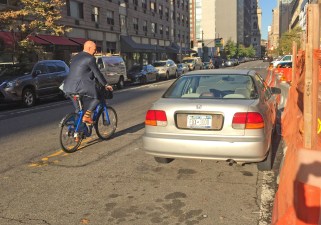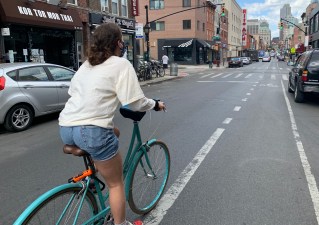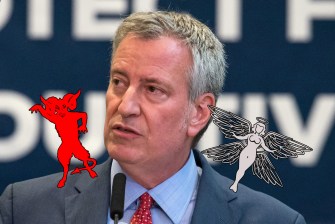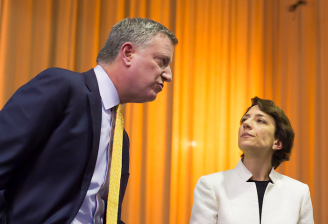The ‘Green Wave’ is a Ripple — But Trottenberg Battles Car Entitlement
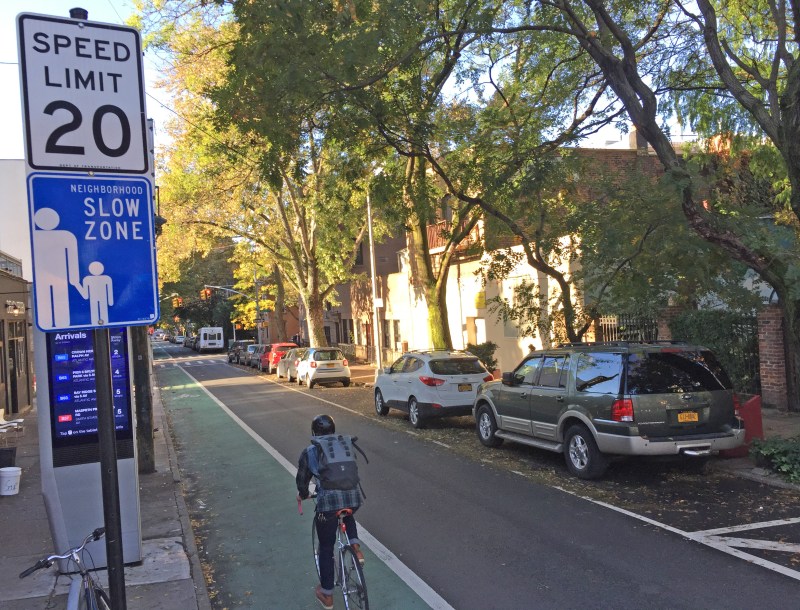
“Green Wave”? More like a pleasant stream.
City officials hyped their latest effort to help city cyclists on Wednesday, announcing that traffic signals on short stretches of two streets in Downtown Brooklyn had been retimed to benefit slower-moving cyclists over fast-moving drivers — but that small treat included a promise to roll out similar changes on just three more roadways citywide next year.
For now, cyclists must be satisfied by light-timing to enhance their riding on stretches of parallel Hoyt and Bond street between Schermerhorn and Baltic streets. The timing of the lights were changed to help cyclists, who tend to move at 10 to 15 miles per hour.
Prince Street in Manhattan (from the Bowery to Sixth Avenue), Clinton Street in Brooklyn (from Hamilton Avenue to Cadman Plaza) and 43rd Avenue in Queens (from Skillman Avenue to Roosevelt Avenue) will get the “green wave” in 2020.
Streetsblog rode up and down the “green wave” roadways in Downtown Brooklyn on Wednesday and found them helpful, but not life-altering. Neither bike lane is protected, so cyclists can’t really enjoy the full “green wave” effect because they are constantly at risk of being right-hooked (on northbound Bond) or left-hooked (on southbound Hoyt). Impatient drivers are not the best company on narrow roads (cops parked in bike lanes don’t help, either).
The same challenges will face cyclists when the “green wave” comes to Prince Street, where the only protection is a strip of green paint. On Clinton Street, cyclists don’t even get the luxury of a different colored pavement. Sunnyside’s 43rd Avenue is the only road where the signal retiming will be paired with actual protected bike infrastructure.
Trottenberg said that the ultimate vision is to spread the signal adjustments to larger cycling routes and key connecting streets, so perhaps the “green wave” will truly one day crash over the entire city. (It is unclear why Trottenberg does not simply ban cars from a few residential streets near the location of her current verdant tide; after all, on Bergen Street, which is a key route for cyclists to the Manhattan and Brooklyn bridges, bikes often outnumber cars during the morning rush, a count provided to Streetsblog by resident Caroline Todd showed.
Still, the commish deserves credit for something much bigger than a paltry single “green wave” on a roadway that was already functioning well enough for cyclists: On Wednesday, she did something city officials rarely do — she pushed back against the city’s dominant car-loving media, which consistently depicts the de Blasio administration of waging a “war” on cars. (At the same time, Streetsblog has criticized Trottenberg for not waging enough of one!)
On Wednesday, she walked from her standard rhetoric that roadways need to be “balanced” for drivers and cyclists, finally telling drivers to live with less.
“The vision here can be there are parts of the city where there are really key cycling routes. And if you’re a motorist and you get on that street, we’re going to be favoring cyclists,” Trottenberg told reporters on Wednesday morning at a press conference to celebrate what the DOT said was the 100th mile of protected bike lane installed by the de Blasio administration.
Even as she was pressed by car-culture champion Marcia Kramer of CBS2 on the alleged inconvenience for drivers who might possibly be slowed down on green wave-treated streets, Trottenberg emphasized the importance of traffic design that helps cyclists. “In New York if you’re behind the wheel, you’re not going to catch that many green lights, particularly in corridors where you see a lot of cyclists,” Trottenberg said.
Joe Cutrufo of Transportation Alternatives said the signal retiming could stand to go further, in particular wherever there are protected bike lanes. But he also praised the program as something that sets specific expectations for a street.
“When you time signals for a particular mode’s average speed, you’re making a declaration,” Cutrufo said. “Vehicles that travel at 15 mph are the intended user. “
Sean Quinn, the DOT’s assistant commissioner for Street Improvement Projects, said that the three additional green wave retimings would be implemented after agency completed an analysis of the current timing. Quinn also said that the key metrics on the new design will be cyclist travel time, cyclist compliance (in terms of obeying red lights) and what traffic patterns wind up looking like as a result of the new signals. Like Trottenberg, Quinn said that the DOT “wasn’t too worried” that driver complaints about being forced to slow down would be an issue.
The broad strokes of Wednesday’s announcement were leaked in advance to the New York Times, where reporter (and self-proclaimed non-Streetsblog reader) Winnie Hu continued to see the news through the implicit bias of the city’s entitled car-owning minority.
Who puts all the pro-car rhetoric into @NYTMetro stories by @WinnHu? It’s relentless and often without fact-checking. Fact: Evening rush speeds for drivers on Hoyt were never fast (nor should they be!). Can @cliffordlevy explain his inane anti-bike edits?https://t.co/fo4hYgj6oW pic.twitter.com/CP1gzOYMvH
— Streetsblog New York (@StreetsblogNYC) October 23, 2019
Hu’s story — like her earlier coverage of the transit priority corridor on 14th Street — consistently presented the DOT’s minor signal timing tweaks as a war on drivers. She insisted that the agency’s re-engineering would dramatically alter conditions on roadways “once dominated by cars” (fact check: all roadways in the “Green Wave” announcement on Wednesday remain dominated by cars).
She also quoted drivers saying that the new light timing slows down their travel speeds, citing no evidence. In fact, the speed limit on Hoyt Street in Cobble Hill is already 20 miles per hour. And as data from 14th Street and Prospect Park West show, overall travel times for drivers often increase by mere seconds after safety or transit improvements, facts not cited by Hu.
“[Cyclists] don’t stop [at lights]. It’s dangerous for everyone,” a driver told Hu. (Fact check: A cyclist who runs a red light may indeed endanger some people, but certainly not people inside cars.)
— with Gersh Kuntzman
